2004 MITSUBISHI ENDEAVOR Windows
[x] Cancel search: WindowsPage 278 of 3870
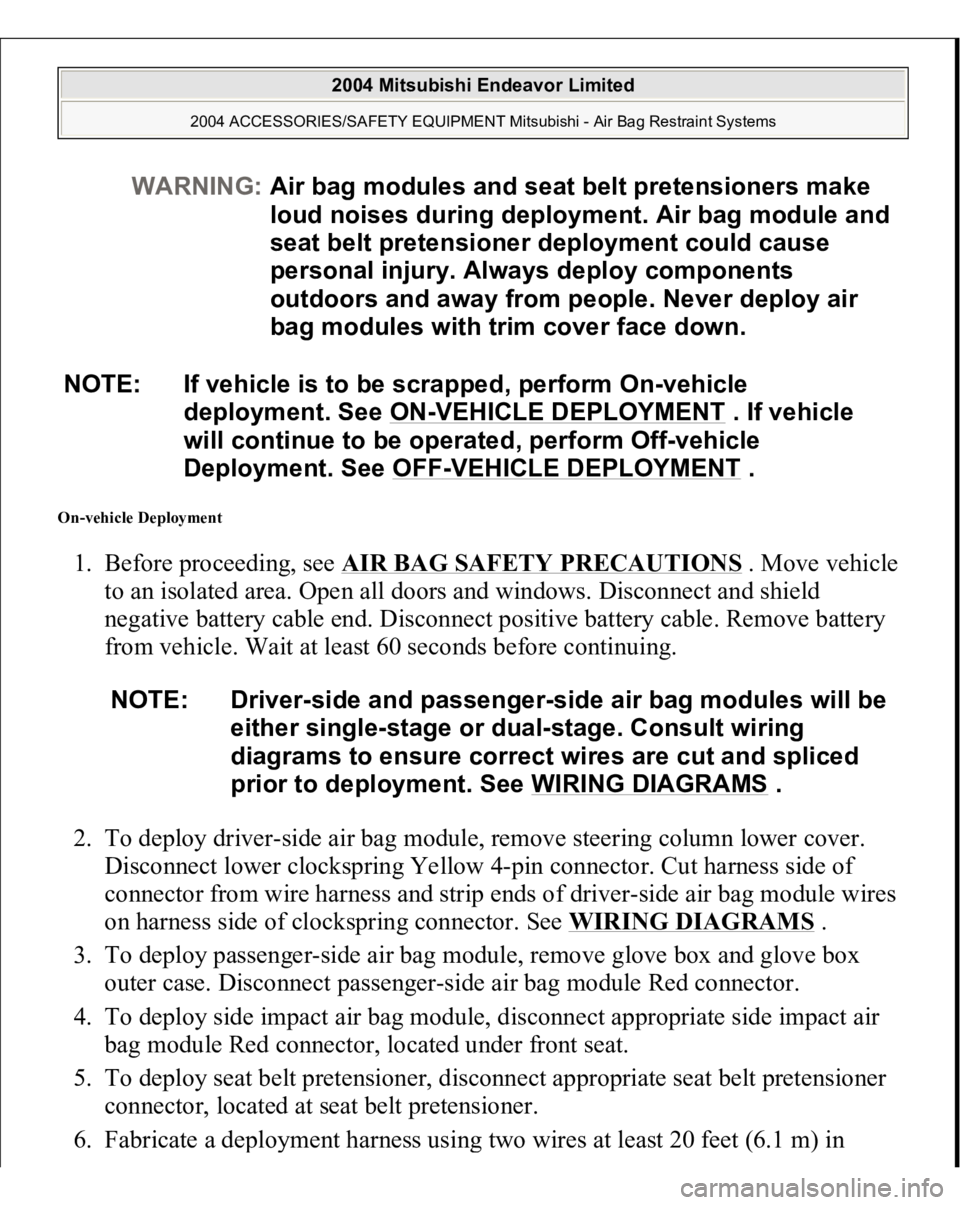
On-vehicle Deployment 1. Before proceeding, see
AIR BAG SAFETY PRECAUTIONS
. Move vehicle
to an isolated area. Open all doors and windows. Disconnect and shield
negative battery cable end. Disconnect positive battery cable. Remove battery
from vehicle. Wait at least 60 seconds before continuing.
2. To deploy driver-side air bag module, remove steering column lower cover.
Disconnect lower clockspring Yellow 4-pin connector. Cut harness side of
connector from wire harness and strip ends of driver-side air bag module wires
on harness side of clockspring connector. See
WIRING DIAGRAMS
.
3. To deploy passenger-side air bag module, remove glove box and glove box
outer case. Disconnect passenger-side air bag module Red connector.
4. To deploy side impact air bag module, disconnect appropriate side impact air
bag module Red connector, located under front seat.
5. To deploy seat belt pretensioner, disconnect appropriate seat belt pretensioner
connector, located at seat belt pretensioner.
6. Fabricate a de
ployment harness usin
g two wires at least 20 feet
(6.1 m
) in
WARNING:Air bag modules and seat belt pretensioners make
loud noises during deployment. Air bag module and
seat belt pretensioner deployment could cause
personal injury. Always deploy components
outdoors and away from people. Never deploy air
bag modules with trim cover face down.
NOTE: If vehicle is to be scrapped, perform On-vehicle
deployment. See ON
-VEHICLE DEPLOYMENT
. If vehicle
will continue to be operated, perform Off-vehicle
Deployment. See OFF
-VEHICLE DEPLOYMENT
.
NOTE: Driver-side and passenger-side air bag modules will be
either single-stage or dual-stage. Consult wiring
diagrams to ensure correct wires are cut and spliced
prior to deployment. See WIRING DIAGRAMS
.
2004 Mitsubishi Endeavor Limited
2004 ACCESSORIES/SAFETY EQUIPMENT Mitsubishi - Air Bag Restraint Systems
Page 279 of 3870
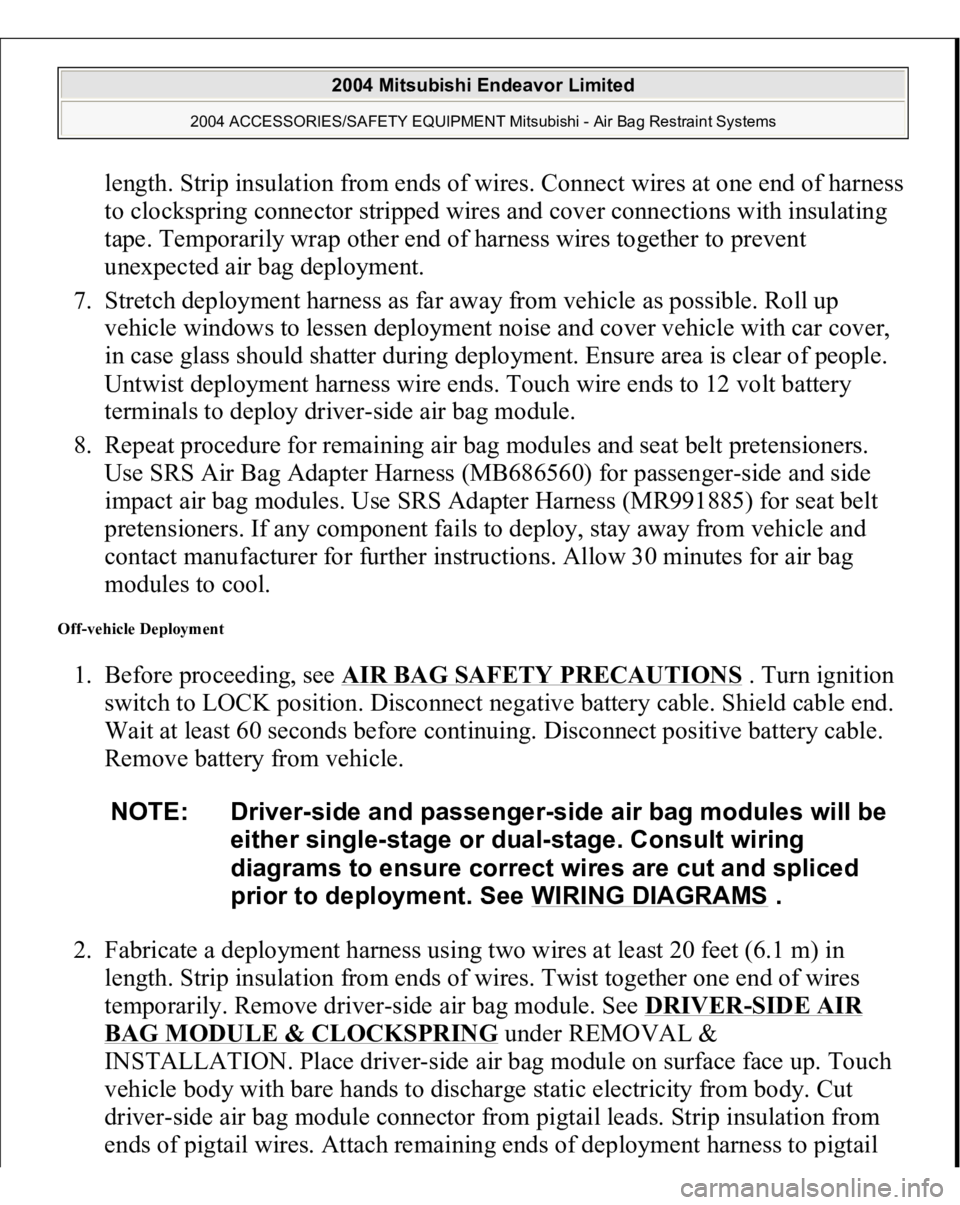
length. Strip insulation from ends of wires. Connect wires at one end of harness
to clockspring connector stripped wires and cover connections with insulating
tape. Temporarily wrap other end of harness wires together to prevent
unexpected air bag deployment.
7. Stretch deployment harness as far away from vehicle as possible. Roll up
vehicle windows to lessen deployment noise and cover vehicle with car cover,
in case glass should shatter during deployment. Ensure area is clear of people.
Untwist deployment harness wire ends. Touch wire ends to 12 volt battery
terminals to deploy driver-side air bag module.
8. Repeat procedure for remaining air bag modules and seat belt pretensioners.
Use SRS Air Bag Adapter Harness (MB686560) for passenger-side and side
impact air bag modules. Use SRS Adapter Harness (MR991885) for seat belt
pretensioners. If any component fails to deploy, stay away from vehicle and
contact manufacturer for further instructions. Allow 30 minutes for air bag
modules to cool.
Off-vehicle Deployment 1. Before proceeding, see
AIR BAG SAFETY PRECAUTIONS
. Turn ignition
switch to LOCK position. Disconnect negative battery cable. Shield cable end.
Wait at least 60 seconds before continuing. Disconnect positive battery cable.
Remove battery from vehicle.
2. Fabricate a deployment harness using two wires at least 20 feet (6.1 m) in
length. Strip insulation from ends of wires. Twist together one end of wires
temporarily. Remove driver-side air bag module. See
DRIVER
-SIDE AIR
BAG MODULE & CLOCKSPRING
under REMOVAL &
INSTALLATION. Place driver-side air bag module on surface face up. Touch
vehicle body with bare hands to discharge static electricity from body. Cut
driver-side air bag module connector from pigtail leads. Strip insulation from
ends of
pigtail wires. Attach remainin
g ends of de
ployment harness to
pigtail NOTE: Driver-side and passenger-side air bag modules will be
either single-stage or dual-stage. Consult wiring
diagrams to ensure correct wires are cut and spliced
prior to deployment. See WIRING DIAGRAMS
.
2004 Mitsubishi Endeavor Limited
2004 ACCESSORIES/SAFETY EQUIPMENT Mitsubishi - Air Bag Restraint Systems
Page 992 of 3870

2004 BODY & ACCESSORIES
Door - Endeavor
GENERAL DESCRIPTION OPERATION CENTRAL DOOR LOCKING SYSTEM The central door locking system operates the door lock actuator to lock or unlock
the doors and liftgate using the door lock switch built into the front power window
(main or sub) switch or key built into the driver's side door outside handle. The
system has the following operations and features:
All doors and liftgate can be locked using the door lock switch built into the
front power window (main or sub) switch. Insert the key into the driver's key cylinder and turn once to the unlock side to
unlock the driver's door. Turn the key once again to the unlock side to unlock
all doors and the liftgate. The key reminder function automatically unlocks all doors and liftgate when
door lock operation is performed and the front doors are opened while the key
is inserted into the ignition switch.
POWER WINDOWS When the power window (main or sub) switch is operated, the door windows will
open or close. This system has the following operations and features:
A power window lock switch on the power window main switch prevents the
door window glass from opening/closing with the front passenger's and rear
power window sub switch. The power window of the door window glass can be opened/closed for 30
seconds with the timer function after the ignition switch is turned OFF. (The
timer expires if the front door < LH or RH> is opened when the timer is in
operation). The power window main switch contains a one-touch down switch that will
automatically open the driver's side door window only.
2004 Mitsubishi Endeavor LS
2004 BODY & ACCESSORIES Door - Endeavor
2004 Mitsubishi Endeavor LS
2004 BODY & ACCESSORIES Door - Endeavor
Page 1017 of 3870
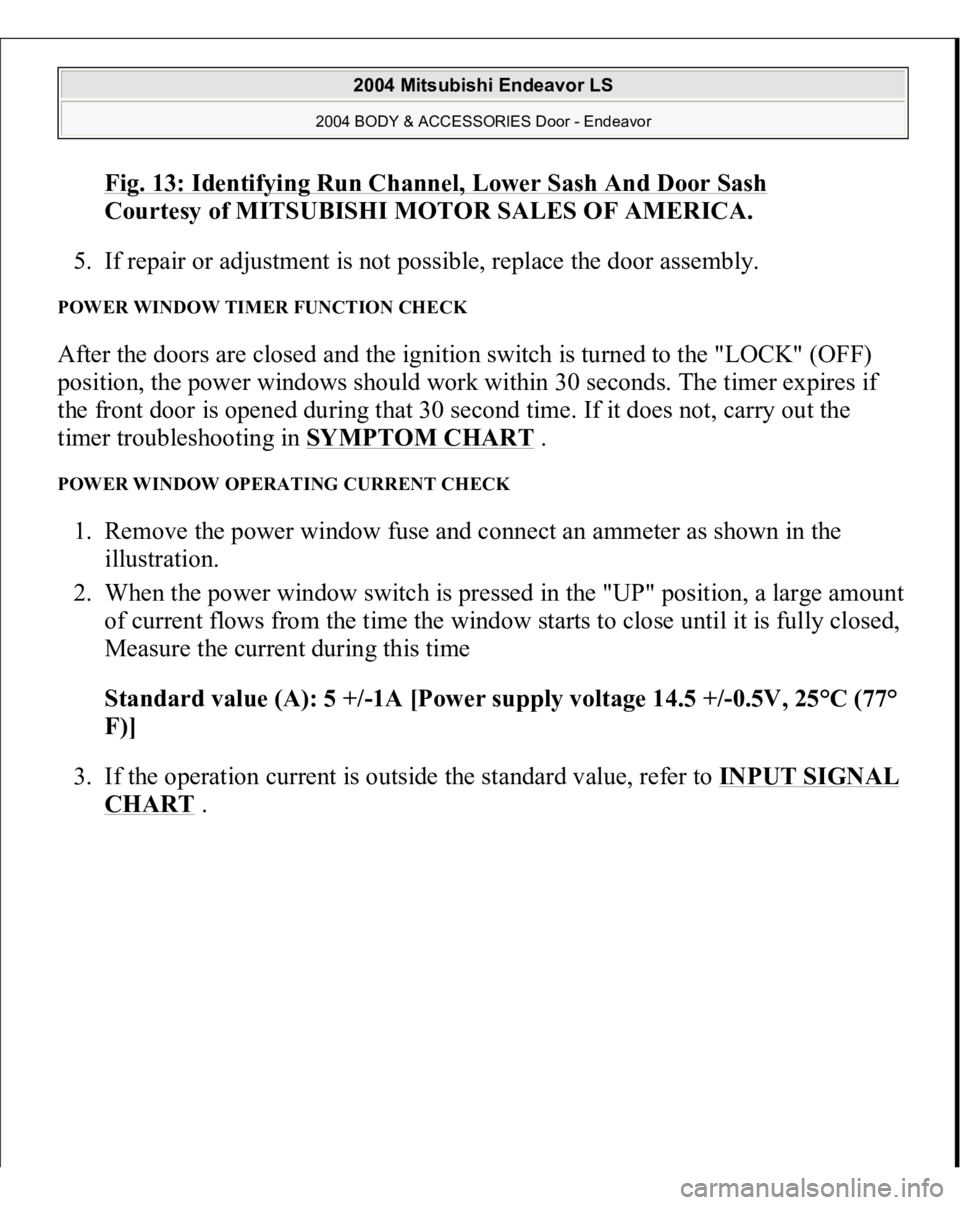
Fig. 13: Identifying Run Channel, Lower Sash And Door Sas
h
Courtesy of MITSUBISHI MOTOR SALES OF AMERICA.
5. If repair or adjustment is not possible, replace the door assembly.
POWER WINDOW TIMER FUNCTION CHECK After the doors are closed and the ignition switch is turned to the "LOCK" (OFF)
position, the power windows should work within 30 seconds. The timer expires if
the front door is opened during that 30 second time. If it does not, carry out the
timer troubleshooting in SYMPTOM CHART
.
POWER WINDOW OPERATING CURRENT CHECK 1. Remove the power window fuse and connect an ammeter as shown in the
illustration.
2. When the power window switch is pressed in the "UP" position, a large amoun
t
of current flows from the time the window starts to close until it is fully closed,
Measure the current during this time
Standard value (A): 5 +/-1A [Power supply voltage 14.5 +/-0.5V, 25°C (77°
F)]
3. If the operation current is outside the standard value, refer to INPUT SIGNAL
CHART
.
2004 Mitsubishi Endeavor LS
2004 BODY & ACCESSORIES Door - Endeavor
Page 1021 of 3870
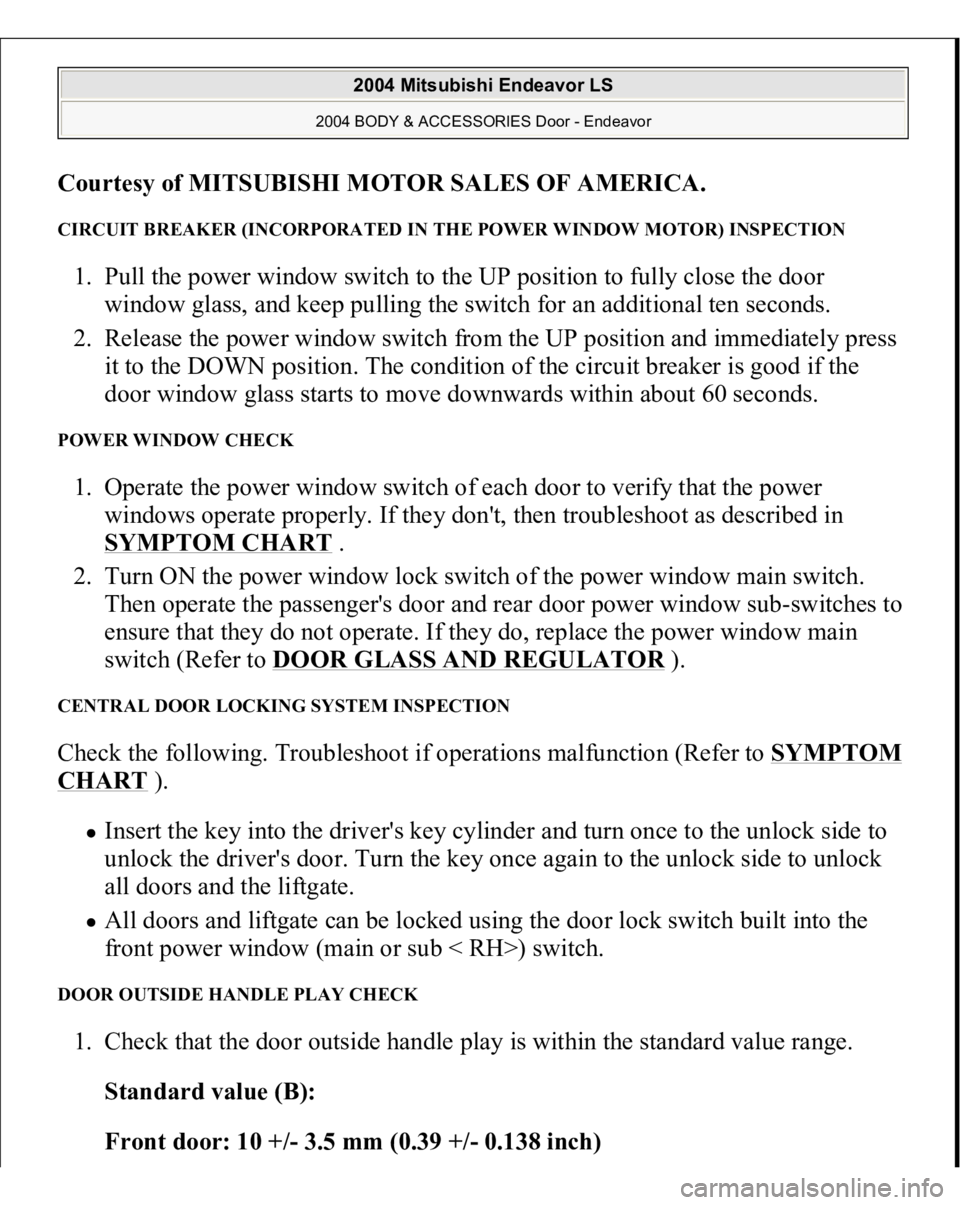
Courtesy of MITSUBISHI MOTOR SALES OF AMERICA
.
CIRCUIT BREAKER (INCORPORATED IN THE POWER WINDOW MOTOR) INSPECTION 1. Pull the power window switch to the UP position to fully close the door
window glass, and keep pulling the switch for an additional ten seconds.
2. Release the power window switch from the UP position and immediately press
it to the DOWN position. The condition of the circuit breaker is good if the
door window glass starts to move downwards within about 60 seconds. POWER WINDOW CHECK 1. Operate the power window switch of each door to verify that the power
windows operate properly. If they don't, then troubleshoot as described in
SYMPTOM CHART
.
2. Turn ON the power window lock switch of the power window main switch.
Then operate the passenger's door and rear door power window sub-switches to
ensure that they do not operate. If they do, replace the power window main
switch (Refer to DOOR GLASS AND REGULATOR
).
CENTRAL DOOR LOCKING SYSTEM INSPECTION Check the following. Troubleshoot if operations malfunction (Refer to SYMPTOM CHART
).
Insert the key into the driver's key cylinder and turn once to the unlock side to
unlock the driver's door. Turn the key once again to the unlock side to unlock
all doors and the liftgate. All doors and liftgate can be locked using the door lock switch built into the
front power window (main or sub < RH>) switch.
DOOR OUTSIDE HANDLE PLAY CHECK 1. Check that the door outside handle play is within the standard value range.
Standard value (B):
Front door: 10 +/- 3.5 mm (0.39 +/- 0.138 inch)
2004 Mitsubishi Endeavor LS
2004 BODY & ACCESSORIES Door - Endeavor
Page 2368 of 3870
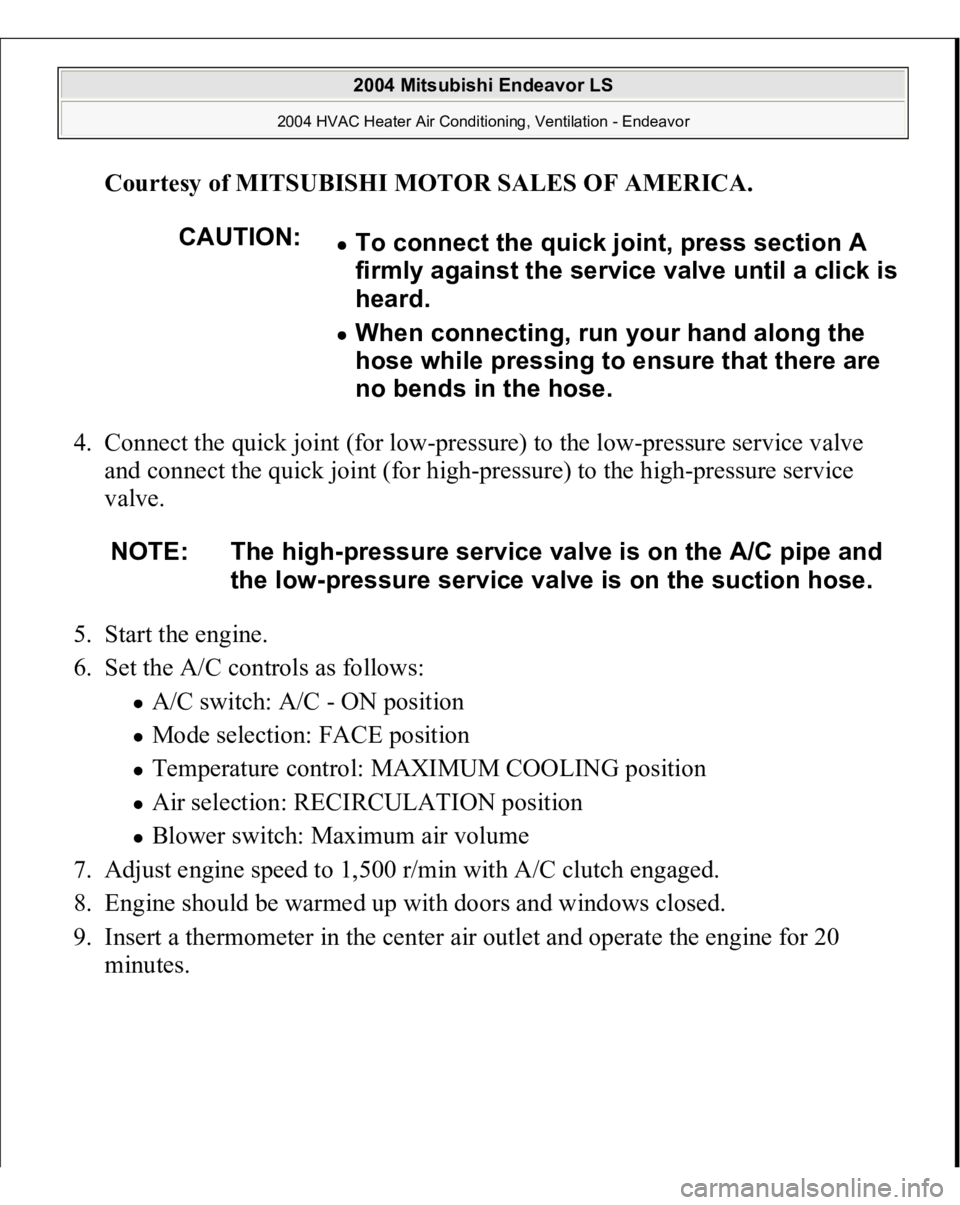
Courtesy of MITSUBISHI MOTOR SALES OF AMERICA
.
4. Connect the quick joint (for low-pressure) to the low-pressure service valve
and connect the quick joint (for high-pressure) to the high-pressure service
valve.
5. Start the engine.
6. Set the A/C controls as follows:
A/C switch: A/C - ON position Mode selection: FACE position Temperature control: MAXIMUM COOLING position Air selection: RECIRCULATION position Blower switch: Maximum air volume
7. Adjust engine speed to 1,500 r/min with A/C clutch engaged.
8. Engine should be warmed up with doors and windows closed.
9. Insert a thermometer in the center air outlet and operate the engine for 20
minutes.
CAUTION:
To connect the quick joint, press section A
firmly against the service valve until a click is
heard. When connecting, run your hand along the
hose while pressing to ensure that there are
no bends in the hose.
NOTE: The high-pressure service valve is on the A/C pipe and
the low-pressure service valve is on the suction hose.
2004 Mitsubishi Endeavor LS
2004 HVAC Heater Air Conditioning, Ventilation - Endeavor
Page 3830 of 3870

Fig. 37: Power Top/Sunroof Circui
t
POWER WINDOWS
2004 Mitsubishi Endeavor LS
2004 SYSTEM WIRING DIAGRAMS Mitsubishi - Endeavor
Page 3832 of 3870

Fig. 38: Power Windows Circui
t
RADI
O
2004 Mitsubishi Endeavor LS
2004 SYSTEM WIRING DIAGRAMS Mitsubishi - Endeavor